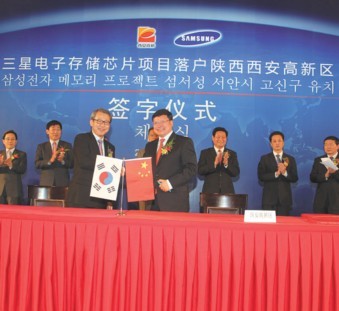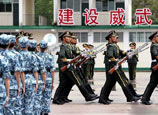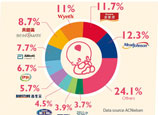
 |
| Samsung invested $7 billion in a memory chip plant in Xi’an last year. |
Transformed over two decades from vast stretches of farmland, the Xi’an High-tech Zone is now the most robust engine driving the city’s modern economy and a window displaying its innovative strengths.
Home to more than 100 renowned global enterprises and Fortune 500 companies including Samsung, Siemens and Schneider, the zone did not flourish in the landlocked city by sheer good fortune.
Of all the factors that helped create success, the primary element has been the high working efficiency of the zone’s administrative committee as well as the practical services it provides to companies.
Among the zone’s projects, Samsung’s is the largest.
“A main reason for it to choose the Xi’an zone rather than coastal industrial parks was our diligence and high efficiency,” said Zhao Hongzhuan, director of the administrative committee.
He noted Samsung sent three questionnaires with a total of about 1,000 questions.
All were answered in detail as soon as possible with practical solutions.
Other praise was given to its government affairs center, which occupies the first and second floor of the zone’s administrative committee office building.
It is a joint working office for various authorities, providing one-stop services for free and helping companies avoid the red tape of submitting the same documents to different agencies.
In 2012, the office processed 1.64 million company requests, issued 7,378 licenses and helped 4,240 new companies finish registration.
In addition, the administrative committee also places a high priority on infrastructure such as transport, water and power transmission lines, to make the zone a convenient and pleasant place to both live and work.
Its well-designed support facilities include schools, hospitals, shopping malls and recreational centers.
It also has six large theme parks that contribute to the total of 7.38 million square meters covered by vegetation. Elite talent has also been crucial to helping grow the enterprise cluster, Zhao said. To attract more talented people, the administrative committee has started a series of funds and launched a project to hire 100 top academics.
From 2011 to 2015, it will invest at least 100 million yuan ($16.2 million) in developing human resources with the aim of attracting and nurturing 30 domestic industrial leaders and 5,000 specialists in four mainstay industries — electronic information, manufacturing, biomedicine and modern services.
To date, the zone has formed eight industrial clusters ranging from telecommunications, optical fiber, semiconductor lighting, electronic devices and components to automobile, innovation-oriented services, software and outsourcing.
And they have attracted both Fortune 500 companies and other famed global enterprises, with the number still increasing.
"Large foreign invested projects will help promote the development of a range of support companies that help complete industrial chains and then further boost our local economy,” Zhao said.
Last year, companies in the zone generated 681 billion yuan in revenues and an industrial output valued at 446 billion yuan.
They also had $8.9 billion worth of imports and exports, 60 percent of the provincial total.


















![]()
